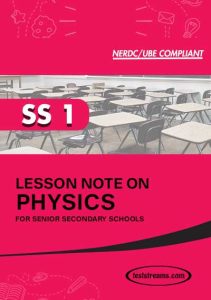This PHYSICS Lesson Note was pulled from our book (Lesson Note on PHYSICS for SS1 MS-WORD); Compiled to serve as reference material to help teachers draw out their lesson plan easier, saving you valuable time to focus on the core job of teaching.
This PHYSICS Lesson Note Covers The Following Topics
- ANALYZING THE DIFFERENT ASPECTS OF PHYSICS, ECONOMIC IMPORTANCE OF PHYSICS, SCHOLARS AND ACHIEVEMENTS IN FIELD OF PHYSICS
- WORK, ENERGY AND POWER
- MEASUREMENT OF LENGTH, MASS, WEIGHT, TIME AND ELECTRIC CHARGE. FUNDAMENTAL AND DERIVED QUANTITIES, DIMENSIONAL ANALYSIS
- TIME: CONCEPTS OF TIME, WAYS OF MEASURING TIME I.E. BOTH OLD AND MODERN METHODS
- DEFINITION, TYPES, CAUSES, PRACTICAL EXAMPLES AND EFFECTS OF CIRCULAR MOTION, CENTRIPETAL AND CENTRIFUGAL FORCES
- DEFINITION, TYPES OF LAW OF FRICTION, REDUCTION, ADVANTAGES AND DISADVANTAGES
- POSITION: DISTANCE, DISPLACEMENT, SPEED, VELOCITY AND DISTANCE-TIME GRAPH
- RECTILINEAR ACCELERATION: CONCEPTS OF ACCELERATION, UNIFORM, NON-UNIFORM ACCELERATION AND VELOCITY – TIME GRAPH
- UPTHRUST AND ARCHIMEDES PRINCIPLE
- DENSITY, RELATIVE DENSITY: DEFINITION AND EXPERIMENT. DETERMINATION OF SOLID AND LIQUID
- UPTHRUST AND ARCHIMEDES’S PRINCIPLE, LAWS OF FLOATATION. PRESSURE: DEFINITION, FORMULAE AND PRACTICAL APPLICATION
- MEASUREMENTS AND UNIT, WORK DONE IN A FORCE FIELD; DEFINITION OF FORCE FIELD, TYPES OF ENERGY AND ENERGY CONVERSION
- DEFINITION AND EFFECTS, TERMINAL VELOCITY AND ITS EXPERIMENTAL VERIFICATION
- FIELD CONCEPT AND TYPES OF FIELD
- HEAT ENERGY, CONCEPT OF HEAT AND TEMPERATURE. EFFECTS OF HEAT: CHANGE OF STATE/ PHASE RISE/FALL IN TEMPERATURE EXPANSION/CONTRACTION, CHANGE OF RESISTANCE, SOURCE, USES OF HEAT
- EVOLUTION OF THE THERMOMETER
- EXPANSIVITY
- HEAT TRANSFER
- PRODUCTION OF CHARGES
- GOLD LEAF ELECTROSCOPE AND ITS USES, LIGHTNING CONDUCTOR
- FIELD CONCEPT AND TYPES OF FIELD
- ELECTRIC FIELD
- PRODUCTION OF CONTINUOUS ELECTRIC CURRENT, CHEMICAL ENERGY, HEAT ENERGY, MECHANICAL ENERGY, SOLAR ENERGY
- ELECTRICITY CONCEPT
- RESISTORS IN SERIES AND PARALLEL
- ELECTRICAL ENERGY AND POWER
- SAFETY DEVICES AND DETECTING FAULTS IN CURRENT
- STRUCTURE 0F MATTER
- SURFACE TENSION
- CAPILLARITY
- ELASTICITY
Sample note
Week 1
Topic: Analyzing the different aspects of Physics, Economic importance of Physics, Scholars and achievements in field of Physics.
Introduction to Physics as a subject
Physics (from Greek φυσική (ἐπιστήμη), i.e. “knowledge of nature”, from φύσις, physics, i.e. “nature” is the natural science that involves the study of matter and its motion through space and time, along with related concepts such as energy and force. More broadly, it is the general analysis of nature, conducted in order to understand how the universe behaves.
Physics is one of the oldest science disciplines, perhaps the oldest through its inclusion of astronomy. Over the last two millennia, physics was a part of natural philosophy along with chemistry, certain branches of mathematics, and biology, but during the Scientific Revolution in the 17th century, the natural sciences emerged as unique research programs in their own right. Physics intersects with many interdisciplinary areas of research, such as biophysics and quantum chemistry, and the boundaries of physics are not rigidly defined. New ideas in physics often explain the fundamental mechanisms of other sciences, while opening new avenues of research in areas such as mathematics and philosophy.
Physics also makes significant contributions through advances that arise from theoretical breakthroughs. For example, advances in the understanding of electromagnetism or nuclear physics led directly to the development of new products which have dramatically transformed modern-day society, such as television, computers, domestic appliances, and nuclear weapons; advances in thermodynamics led to the development of industrialization; and advances in mechanics inspired the development of calculus.
Economic Importance of Physics; Using the UK as a case study.
More than 500 000 people are employed in high-value physics-based manufacturing in the UK, contributing more than £20 billion to the UK economy directly, and creating products and devices that enable growth in the aerospace and electricity generation sectors. Physics technologies such as photonics and precision optics drive progress in the information economy and the life sciences. Physics drives employment across the UK. Large employers such as Seagate in Northern Ireland use physics to develop advanced computer hard drives; Oxford Instruments is a world-leading manufacturer and exporter of scientific equipment used in the development of novel materials. More people are employed in physics- based businesses in the UK than in both the finance and construction sectors. The recent economic downturn affected physics-based sectors as much as the broader economy, but the signs are there that physics can lead the recovery.
Exports from physics-based business amounted to more than £100B in 2009,
physics-based business in the UK account for more exports as a share of the total
than those in France. Physics-based sectors have increased their investment in research and development in the years following the crash.
For the UK economy to grow and be rebalanced in favor of high-tech, knowledge-intensive industries, there must be more and more-focused support for physics-based businesses through innovative public procurement and more ready access to the capital essential for growth. This, combined with sustained and stable funding of physics research and a ready supply of physics-trained workers, will allow physics – and the economy – to thrive
Scholars and achievements in the field of Physics.
Father of Physics: unarguably there is no way you would talk about the subject ‘Physics’ from the simple to the complex aspects without having to mention names of those who subjected themselves to thorough study of the subject and came out with all sorts of theories founded on commitment to achieve their set pursuits. Names go thus;
Sir Isaac Newton (1643-1727), Albert Einstein (1879-1955), Max Planck (1858-1947), Nicholas Copernicus, William Gilbert, Galileo Galilei (1564-1642), Nicholas Copernicus (1473-1543), Pierre-Simon Laplace, Michael Faraday (1791-1867), Rudolph Claudius, Ludwig Boltzmann, Marie and Pierre Curie, Louis De Broglie, Paul Dirac, James Prescott Joule. To mention but a very few of them, you can play around with and be conscious of this names to remind yourself of the progenitors of Physics, this makes you a more learned person than your contemporaries.
Highlights of some branches of Physics; involvements and contributions.
NB: Coverage here will be restricted to the limited scope of the knowledge of this class, so as not to overload and beat beyond the capacity of understanding at this level.
Classical physics became a separate science when early modern Europeans used these experimental and quantitative methods to discover what are now considered to be the laws of physics. Kepler, Galileo and more specifically Newton discovered and unified the different laws of motion. During the industrial revolution, as energy needs increased, so did research, which led to the discovery of new laws in thermodynamics, chemistry and electromagnetic.
Modern physics started with the works of Max Planck in quantum theory and Einstein in relativity, and continued in quantum mechanics pioneered by Heisenberg, Schrödinger and Paul Dirac. Classical physics is generally concerned with matter and energy on the normal scale of observation, while much of modern physics is concerned with the behavior of matter and energy under extreme conditions or on a very large or very small scale. For example, atomic and nuclear physics studies matter on the smallest scale at which chemical elements can be identified. The physics of elementary particles is on an even smaller scale, as it is concerned with the most basic units of matter; this branch of physics is also known as high-energy physics because of the extremely high energies necessary to produce many types of particles in large particle accelerators. On this scale, ordinary common sense notions of space, time, matter, and energy are no longer valid.
Uniform motion in a straight line and the general theory of relativity with accelerated motion, the two chief theories of modern physics present a different picture of the concepts of space, time, and matter from that presented by classical physics. Quantum theory is concerned with the discrete, rather than continuous, nature of many phenomena at the atomic and subatomic level, and with the complementary aspects of particles and waves in the description of such phenomena. The theory of relativity is concerned with the description of phenomena that take place in a frame of reference that is in motion with respect to an observer; the special theory of relativity is concerned with relative and its connection with gravitation. Both quantum theory and the theory of relativity find applications in all areas of modern physics.
Lets end it here so as not to go too much beyond the scope of this class, already we have gone a little beyond, however it is a way to go, in order to prepare you for the greater future, should you nurture ambition to be in the line of Physics related course(s).

Get the complete Lesson Note with more content at very affordable price. Lesson Note on PHYSICS for SS1 MS-WORD- PDF
![]()


